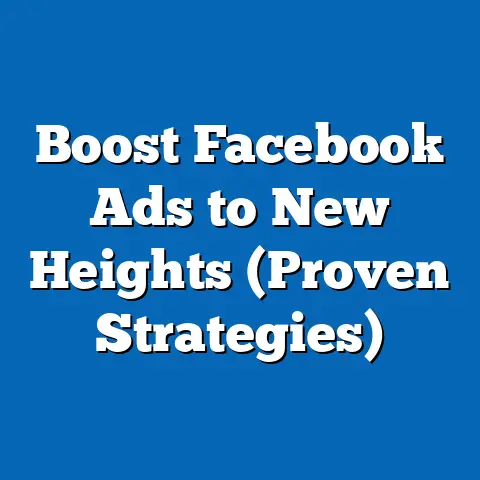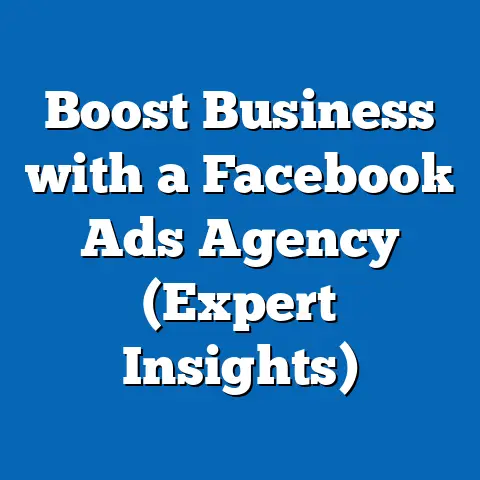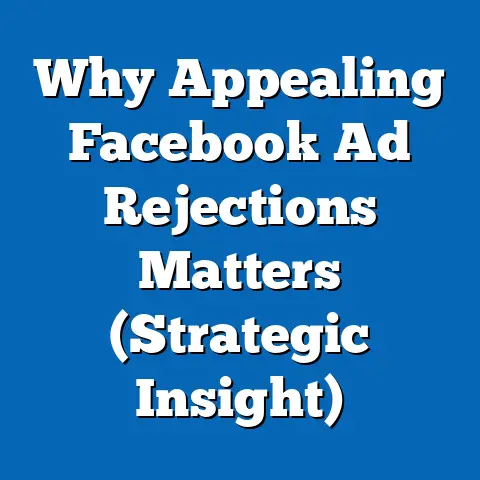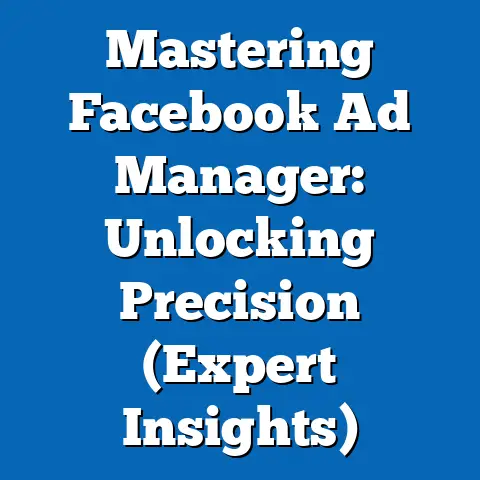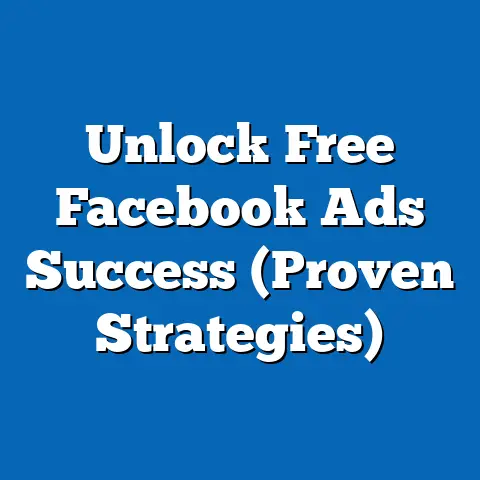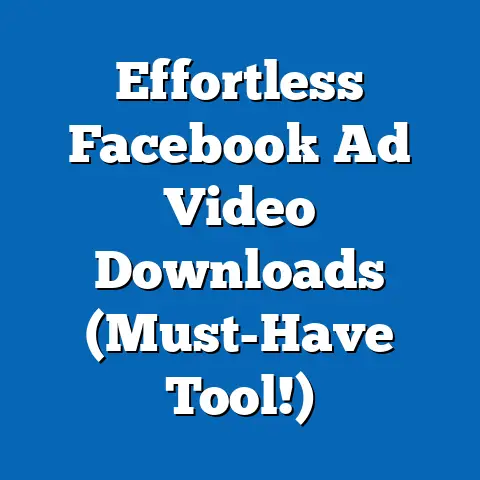Navigating New Facebook Ads Guidelines (Essential Strategies)
Facebook advertising is a powerhouse for businesses of all sizes, offering unparalleled reach and targeting capabilities. But let’s be honest, keeping up with the ever-changing Facebook Ads guidelines can feel like trying to hit a moving target. I’ve seen firsthand how these frequent updates can throw even the most seasoned marketers for a loop, leading to wasted ad spend, disapproved ads, and missed opportunities to connect with your audience.
I remember working with a local bakery that was launching a new line of gluten-free treats. They had a fantastic ad campaign ready to go, featuring mouthwatering photos and compelling copy. But within a week, their ads were repeatedly disapproved due to a subtle violation of Facebook’s health and wellness advertising policies. It took hours of research and revisions to get their ads back on track, a frustrating experience that could have been avoided with better preparation.
Understanding the Facebook Ads Ecosystem
Facebook, with its billions of active users, presents an unparalleled opportunity for businesses to connect with their target audiences. The Facebook Ads ecosystem is a complex but powerful machine, offering a wide array of tools and features designed to help you reach the right people with the right message.
The Reach and Power of Facebook Advertising
Facebook isn’t just a social media platform; it’s a global advertising hub. According to Statista, Facebook has nearly 3 billion monthly active users. That’s a massive audience, and Facebook’s advanced targeting options allow you to narrow that audience down to the individuals most likely to be interested in your products or services.
Think about it: you can target users based on demographics (age, gender, location), interests (hobbies, favorite brands, pages they like), behaviors (purchase history, online activity), and even connections (friends of people who like your page). This level of granularity is unmatched by most other advertising platforms.
Audience Targeting Capabilities
One of the key strengths of Facebook Ads is its robust targeting capabilities. You can create custom audiences based on your existing customer data (email lists, website visitors, app users), allowing you to re-engage with people who already know your brand. You can also create lookalike audiences, which are audiences that share similar characteristics with your existing customers, expanding your reach to new potential customers.
I’ve personally seen businesses achieve incredible results by leveraging these targeting options. For example, a local bookstore was able to increase its online sales by 30% by targeting users who had previously visited their website and shown interest in specific genres.
Ad Formats: A Variety of Options
Facebook offers a variety of ad formats to suit different objectives and creative styles. These include:
- Image Ads: Simple and effective for showcasing products or services with compelling visuals.
- Video Ads: Engaging and dynamic for telling stories and capturing attention.
- Carousel Ads: Allow users to scroll through multiple images or videos in a single ad unit, perfect for showcasing a range of products or features.
- Collection Ads: Designed for e-commerce, these ads feature a hero image or video followed by a selection of related products.
- Lead Ads: Collect lead information directly within Facebook, making it easy for users to sign up for newsletters, request quotes, or download resources.
- Instant Experience Ads: Full-screen, mobile-optimized experiences that load instantly when clicked, providing an immersive and engaging way to showcase your brand.
Choosing the right ad format is crucial for maximizing your campaign’s performance. I always recommend testing different formats to see which ones resonate best with your target audience.
Facebook Ads in the Broader Digital Marketing Context
Facebook Ads don’t operate in a vacuum. They’re most effective when integrated with a broader digital marketing strategy that includes SEO, content marketing, and other social media platforms.
For example, you can use Facebook Ads to drive traffic to your website, where users can learn more about your products or services and ultimately convert into customers. You can also use Facebook Ads to promote your blog content, increasing your website’s visibility in search engine results.
I’ve found that businesses that align their Facebook Ads with their overall marketing goals tend to see the best results. Think of Facebook Ads as one piece of a larger puzzle, working in harmony with your other marketing efforts to achieve your business objectives.
Key Takeaway: The Facebook Ads ecosystem is a powerful tool for reaching your target audience and achieving your business goals. Understanding its reach, targeting capabilities, and ad formats is essential for creating effective campaigns. Remember to integrate your Facebook Ads with your broader digital marketing strategy for maximum impact.
Recent Changes to Facebook Ads Guidelines
Staying up-to-date with Facebook Ads guidelines is like navigating a constantly shifting landscape. Facebook regularly updates its policies to improve user experience, protect user privacy, and combat misinformation. While these changes are often well-intentioned, they can create headaches for marketers who aren’t prepared.
Key Updates in Facebook Ads Guidelines
In recent years, Facebook has implemented several significant changes to its advertising guidelines. Some of the most notable include:
- Enhanced Transparency Requirements: Facebook now requires advertisers to provide more information about their identity and location, as well as the purpose of their ads. This is designed to increase transparency and prevent deceptive advertising practices.
- Restrictions on Sensitive Targeting: Facebook has limited the ability to target users based on sensitive categories such as race, ethnicity, religion, and sexual orientation. This is intended to prevent discrimination and protect vulnerable groups.
- Stricter Policies on Health and Wellness Claims: Facebook has tightened its policies on health and wellness advertising, requiring advertisers to provide evidence to support any claims they make about the effectiveness of their products or services. This is aimed at combating misinformation and protecting users from false or misleading health claims.
- Increased Focus on User Privacy: Facebook has introduced new features and policies to give users more control over their data and how it’s used for advertising. This includes allowing users to opt out of certain types of targeting and providing more transparency about how their data is being used.
- Combating Misinformation and Disinformation: Facebook has taken steps to combat the spread of misinformation and disinformation on its platform, including stricter policies on political advertising and the removal of content that violates its community standards.
These are just a few of the many changes that Facebook has made to its advertising guidelines in recent years. It’s crucial to stay informed about these changes and adapt your advertising strategies accordingly.
Why These Changes? Facebook’s Perspective
Facebook’s primary goal is to provide a positive user experience. The changes to its advertising guidelines are largely driven by this goal. By increasing transparency, protecting user privacy, and combating misinformation, Facebook aims to create a safer and more trustworthy environment for its users.
From Facebook’s perspective, these changes are necessary to maintain user trust and ensure the long-term sustainability of its platform. However, they can also create challenges for marketers who are trying to reach their target audiences and achieve their business goals.
Impacted Ad Types: Examples and Insights
Certain types of ads have been particularly impacted by the recent changes to Facebook Ads guidelines. These include:
- Ads Related to Sensitive Topics: Ads that touch on sensitive topics such as politics, religion, or social issues are now subject to stricter scrutiny and may require additional disclosures.
- Ads Making Health or Wellness Claims: Ads that make claims about the effectiveness of health or wellness products or services must be supported by credible evidence and comply with specific guidelines.
- Ads Targeting Specific Demographics: Ads that target users based on sensitive demographics such as race, ethnicity, or sexual orientation may be restricted or prohibited altogether.
- Ads with Misleading or Deceptive Content: Ads that contain false or misleading information are strictly prohibited and will be removed from the platform.
I’ve seen many businesses struggle to adapt to these changes, particularly those in the health and wellness industry. It’s essential to carefully review your ad content and targeting to ensure that you’re complying with the latest guidelines.
Key Takeaway: Facebook Ads guidelines are constantly evolving, and it’s crucial to stay informed about the latest changes. These changes are often driven by Facebook’s commitment to user experience and safety, but they can also create challenges for marketers. Be sure to carefully review your ad content and targeting to ensure that you’re complying with the latest guidelines and avoiding common pitfalls.
Strategies for Adapting to New Guidelines
Navigating the ever-changing landscape of Facebook Ads guidelines requires a proactive and adaptable approach. It’s not enough to simply create your ads and hope for the best; you need to stay informed, review your content, adjust your targeting, and continuously test your strategies. Here are some actionable strategies that I’ve found to be effective in helping businesses adapt to new guidelines:
Research and Stay Updated
The first step in adapting to new Facebook Ads guidelines is to stay informed. This means regularly checking for updates on Facebook’s official resources, as well as staying abreast of industry news and best practices.
- Facebook Business Help Center: This is your go-to resource for all things Facebook Ads. It contains detailed information about Facebook’s advertising policies, as well as troubleshooting tips and best practices.
- Facebook for Business Blog: This blog features articles and case studies about the latest trends in Facebook advertising, as well as insights from Facebook experts.
- Industry News and Blogs: Stay up-to-date on the latest news and trends in digital marketing by following reputable industry blogs and publications.
- Join Facebook Groups and Forums: Connect with other marketers and share insights and advice in Facebook groups and forums dedicated to Facebook advertising.
I make it a habit to check these resources at least once a week to stay on top of any new developments or changes. It’s also helpful to set up Google Alerts for keywords related to Facebook Ads guidelines, so you’ll be notified whenever there’s a new article or blog post on the topic.
Ad Content Review
Once you’re aware of the latest guidelines, it’s time to review your ad content to ensure that it complies with the new rules. This means carefully examining your ad copy, images, videos, and landing pages to identify any potential violations.
- Check for Prohibited Content: Make sure your ads don’t contain any prohibited content, such as hate speech, violence, or misinformation.
- Verify Health and Wellness Claims: If your ads make claims about the effectiveness of health or wellness products or services, ensure that these claims are supported by credible evidence.
- Avoid Misleading or Deceptive Content: Make sure your ads are accurate and truthful, and don’t contain any misleading or deceptive information.
- Ensure Compliance with Privacy Policies: Make sure your ads comply with Facebook’s privacy policies and don’t collect or use user data in a way that violates these policies.
I often recommend creating a checklist of all the relevant guidelines and using it to systematically review your ad content. It’s also helpful to have a second pair of eyes review your ads to catch any potential violations that you might have missed.
Targeting Adjustments
In addition to reviewing your ad content, you may also need to adjust your targeting methods in light of new restrictions or changes. This means carefully examining your audience targeting options and making sure that you’re not targeting users based on sensitive categories or in a way that violates Facebook’s policies.
- Avoid Sensitive Targeting: Refrain from targeting users based on sensitive categories such as race, ethnicity, religion, or sexual orientation.
- Use Broad Targeting Options: Consider using broad targeting options such as interests or behaviors to reach a wider audience.
- Leverage Custom and Lookalike Audiences: Create custom audiences based on your existing customer data and use lookalike audiences to expand your reach to new potential customers.
- Test Different Targeting Options: Experiment with different targeting options to see which ones perform best and comply with Facebook’s policies.
I’ve found that it’s often better to err on the side of caution when it comes to targeting. It’s better to reach a slightly broader audience than to risk violating Facebook’s policies and having your ads disapproved.
Creative Testing
The final strategy for adapting to new guidelines is to continuously test your ad variations to understand which ones perform well under the new rules. This means experimenting with different ad copy, images, videos, and targeting options to see what resonates best with your target audience.
- A/B Testing: Use A/B testing to compare different ad variations and see which ones perform best.
- Multivariate Testing: Use multivariate testing to test multiple elements of your ads at the same time.
- Monitor Performance Metrics: Track key performance metrics such as click-through rate, conversion rate, and cost per acquisition to see how your ads are performing.
- Adjust Your Strategies: Based on your testing results, adjust your ad content, targeting, and bidding strategies to optimize your campaign’s performance.
I’m a firm believer in the power of testing. It’s the only way to truly understand what works and what doesn’t. By continuously testing your ads and analyzing the results, you can stay ahead of the curve and ensure that your campaigns are always performing at their best.
Key Takeaway: Adapting to new Facebook Ads guidelines requires a proactive and adaptable approach. Stay informed about the latest changes, review your ad content, adjust your targeting, and continuously test your strategies. By following these steps, you can ensure that your Facebook Ads are not only compliant but also effective.
Case Studies of Successful Adaptation
To further illustrate how businesses can successfully adapt to new Facebook Ads guidelines, let’s take a look at a few real-world case studies. These examples highlight the challenges faced, the strategies employed, and the outcomes achieved by businesses navigating these changes.
Case Study 1: A Health and Wellness Brand
Challenge: A health and wellness brand selling dietary supplements faced increased scrutiny and disapprovals due to stricter policies on health claims. Their ads, which previously highlighted specific health benefits of their products, were now being flagged for violating Facebook’s advertising policies.
Strategy:
- Revised Ad Copy: The brand completely overhauled their ad copy, focusing on general wellness and lifestyle benefits rather than specific health claims. They emphasized the ingredients and their natural origins, without making explicit promises about health outcomes.
- Customer Testimonials: They incorporated customer testimonials that focused on how the products made them feel, rather than claiming specific health improvements.
- Compliance Review: They hired a consultant specializing in Facebook Ads compliance to review all their ad content and targeting options.
- A/B Testing: They ran A/B tests to compare the performance of the revised ads against the older versions, ensuring that the new ads were still effective.
Outcome:
- Ad approvals increased significantly.
- While initial engagement was slightly lower, the brand saw a more sustainable and compliant advertising strategy.
- Customer feedback remained positive, and the brand maintained its reputation for quality and transparency.
Key Takeaway: This case study demonstrates the importance of adapting ad copy to comply with stricter health claim policies. By focusing on general wellness and using customer testimonials carefully, the brand was able to maintain its advertising effectiveness without violating Facebook’s guidelines.
Case Study 2: A Political Advocacy Group
Challenge: A political advocacy group promoting a specific policy initiative faced challenges due to increased transparency requirements and restrictions on sensitive targeting. Their ads, which previously targeted specific demographic groups, were now subject to additional scrutiny and limitations.
Strategy:
- Transparency Disclosure: The group prominently displayed its funding sources and political affiliation in all its ads, complying with Facebook’s transparency requirements.
- Broadened Targeting: They broadened their targeting options to include users interested in related topics and issues, rather than focusing on specific demographic groups.
- Engaging Content: They created engaging video content that explained the policy initiative in a clear and unbiased manner, focusing on the facts and avoiding inflammatory language.
- Community Engagement: They actively engaged with users in the comments section of their ads, addressing concerns and answering questions in a respectful and informative way.
Outcome:
- Ad approvals remained consistent.
- The group reached a wider audience than before, increasing awareness of the policy initiative.
- Positive engagement and constructive dialogue were fostered in the comments section of their ads.
Key Takeaway: This case study highlights the importance of transparency and engaging content in political advertising. By complying with Facebook’s transparency requirements and focusing on factual information, the group was able to reach a wider audience and promote its policy initiative effectively.
Case Study 3: An E-commerce Business
Challenge: An e-commerce business selling apparel faced challenges due to changes in Facebook’s privacy policies. Their ads, which previously relied on detailed user data for targeting, were now subject to limitations on data collection and usage.
Strategy:
- First-Party Data: The business shifted its focus to collecting and utilizing first-party data, such as email addresses and purchase history, to create custom audiences.
- Website Tracking: They implemented advanced website tracking to monitor user behavior and identify potential customers based on their browsing activity.
- Lookalike Audiences: They used lookalike audiences to expand their reach to new potential customers who shared similar characteristics with their existing customers.
- Personalized Ads: They created personalized ads that showcased products based on users’ past purchases and browsing history.
Outcome:
- Ad performance remained strong.
- The business improved its customer relationships by providing more personalized and relevant advertising experiences.
- Increased customer loyalty and repeat purchases were observed.
Key Takeaway: This case study emphasizes the importance of leveraging first-party data and personalized advertising in light of privacy policy changes. By focusing on building direct relationships with customers and providing relevant content, the business was able to maintain its advertising effectiveness and improve customer loyalty.
Key Takeaway: These case studies demonstrate that adapting to new Facebook Ads guidelines requires a combination of creativity, compliance, and data-driven decision-making. By staying informed, reviewing your content, adjusting your targeting, and continuously testing your strategies, you can navigate these changes successfully and achieve your advertising goals.
Tools and Resources for Facebook Ad Compliance
Navigating the complexities of Facebook Ad compliance can be overwhelming, but thankfully, there are numerous tools and resources available to help you stay on track. I’ve compiled a list of some of the most valuable resources that I’ve used and recommend to others:
Ad Creation and Management Tools
- Facebook Ads Manager: This is the primary tool for creating and managing your Facebook Ads campaigns. It provides a user-friendly interface for setting up your campaigns, targeting your audience, and tracking your results.
- Power Editor: A more advanced tool for managing large and complex Facebook Ads campaigns. It offers features such as bulk editing, advanced reporting, and automated rules.
- Third-Party Ad Management Tools: Several third-party tools, such as AdEspresso, Hootsuite Ads, and SocialPilot, offer additional features for managing your Facebook Ads campaigns, such as A/B testing, reporting, and automation.
Compliance Check Tools
- Facebook’s Ad Review Process: Facebook automatically reviews all ads to ensure that they comply with its advertising policies. If your ad is disapproved, you’ll receive a notification with details about why it was rejected.
- Third-Party Compliance Check Tools: Some third-party tools, such as Prowly and BrandVerity, offer automated compliance checks to help you identify potential violations before your ads are submitted to Facebook.
Analytics and Performance Measurement Tools
- Facebook Analytics: This tool provides detailed insights into your Facebook Ads performance, including metrics such as reach, impressions, clicks, conversions, and cost per acquisition.
- Google Analytics: Integrate Google Analytics with your Facebook Ads campaigns to track website traffic and conversions generated by your ads.
- Third-Party Analytics Tools: Several third-party analytics tools, such as Mixpanel and Kissmetrics, offer more advanced features for tracking user behavior and measuring the effectiveness of your Facebook Ads campaigns.
Community Forums, Expert Blogs, and Facebook Groups
- Facebook’s Help Community: This is a great place to ask questions and get answers from other Facebook Ads users.
- Industry Blogs and Publications: Stay up-to-date on the latest trends in Facebook advertising by following reputable industry blogs and publications.
- Facebook Groups: Join Facebook groups dedicated to Facebook advertising to connect with other marketers and share insights and advice.
I’ve found that engaging with the Facebook Ads community is incredibly valuable. There are always experienced marketers willing to share their knowledge and help you navigate the complexities of the platform.
Key Takeaway: There are numerous tools and resources available to help you ensure that your Facebook Ads comply with Facebook’s guidelines and achieve your advertising goals. By leveraging these resources, you can stay informed, review your content, adjust your targeting, and continuously test your strategies to optimize your campaign’s performance.
Conclusion
Navigating the ever-evolving landscape of Facebook Ads guidelines can feel like a daunting task. However, by understanding the Facebook Ads ecosystem, staying informed about recent guideline changes, implementing effective adaptation strategies, and leveraging the available tools and resources, you can not only ensure compliance but also maximize your advertising ROI.
I hope this guide has provided you with the knowledge and tools you need to navigate these challenges with confidence. Remember, the key to success is to view these changes not as obstacles, but as opportunities for growth and improvement. By embracing a proactive and adaptable approach, you can stay ahead of the curve and position yourself as a leader in the world of Facebook advertising.
So, take the information I’ve shared and put it into action. Start by reviewing your current ad campaigns and identifying any potential violations of Facebook’s guidelines. Then, implement the strategies I’ve outlined to adapt your content, targeting, and bidding strategies. And finally, leverage the tools and resources I’ve recommended to stay informed and optimize your campaign’s performance.
Remember, mastering the art of Facebook advertising is an ongoing journey. It requires continuous learning, experimentation, and adaptation. But with the right knowledge, tools, and mindset, you can achieve incredible results and drive significant growth for your business. Now, go out there and make your Facebook Ads shine!

